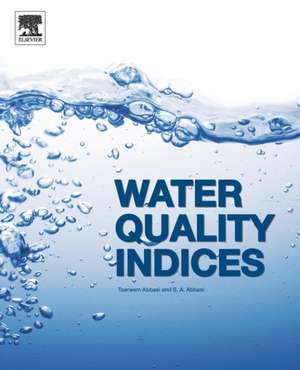Water Quality Indices
Autor Tabassum Abbasi, S. a. Abbasien Limba Engleză Paperback – 19 aug 2016
Whereas it is easy to express the quantity of water, it is very difficult to express its quality because a large number of variables determine the water quality. WQIs seek to resolve the difficulty by translating a set of a large number of variables to a one-digit or a two-digit numeral. They are essential in communicating the status of different water resources in terms of water quality and the impact of various factors on it to policy makers, service personnel, and the lay public. Further they are exceedingly useful in the monitoring and management of water quality.
With the importance of water and water quality increasing exponentially, the importance of this topic is also set to increase enormously because only with the use of indices is it possible to assess, express, communicate, and monitor the overall quality of any water source.
- Provides a concise guide to WQIs: their purpose and generation
- Compares existing methods and WQIs and outlines strengths and weaknesses
- Makes recommendations on how the indices should be used and under what circumstances they apply
Preț: 473.04 lei
Preț vechi: 514.17 lei
-8% Nou
Puncte Express: 710
Preț estimativ în valută:
90.53€ • 94.16$ • 74.74£
90.53€ • 94.16$ • 74.74£
Carte tipărită la comandă
Livrare economică 07-21 aprilie
Preluare comenzi: 021 569.72.76
Specificații
ISBN-13: 9780444638366
ISBN-10: 0444638369
Pagini: 384
Dimensiuni: 191 x 235 mm
Greutate: 0.64 kg
Editura: ELSEVIER SCIENCE
ISBN-10: 0444638369
Pagini: 384
Dimensiuni: 191 x 235 mm
Greutate: 0.64 kg
Editura: ELSEVIER SCIENCE
Cuprins
Part 1: Water Quality Indices Based Predominantly on Physico-chemical characteristics
1. Why water quality indices2. Approaches to WQI formulation3. Conventional Indices for determining fitness of waters for different uses4. Combating uncertainities in indice-based assessment of water quality: The use of more advanced statistics, probability theory, and artificial intelligence5. Indices based on relatively advanced statistical analysis of water quality data6. Water quality indices based on fuzzy logic and other methods of artificial intelligence7. Probabilistic or stochastic water quality indices8. Planning or decision – making indices9. Indices for assessing groundwater quality10. Water quality indices of USA and Canada11. WQI generating software and a WQI-based virtual instrument
Part 2: Water Quality Indices Based on Bioassessment
12. Water quality indices based on bioassessment: an introduction13. The biotic indices14. Indices of biological integrity or the multimetric indices15. Multivariate approaches for bioassessment of water quality
Part 3: Looking Back, Looking Ahead
16. Water quality indices : Looking back, looking ahead
1. Why water quality indices2. Approaches to WQI formulation3. Conventional Indices for determining fitness of waters for different uses4. Combating uncertainities in indice-based assessment of water quality: The use of more advanced statistics, probability theory, and artificial intelligence5. Indices based on relatively advanced statistical analysis of water quality data6. Water quality indices based on fuzzy logic and other methods of artificial intelligence7. Probabilistic or stochastic water quality indices8. Planning or decision – making indices9. Indices for assessing groundwater quality10. Water quality indices of USA and Canada11. WQI generating software and a WQI-based virtual instrument
Part 2: Water Quality Indices Based on Bioassessment
12. Water quality indices based on bioassessment: an introduction13. The biotic indices14. Indices of biological integrity or the multimetric indices15. Multivariate approaches for bioassessment of water quality
Part 3: Looking Back, Looking Ahead
16. Water quality indices : Looking back, looking ahead
